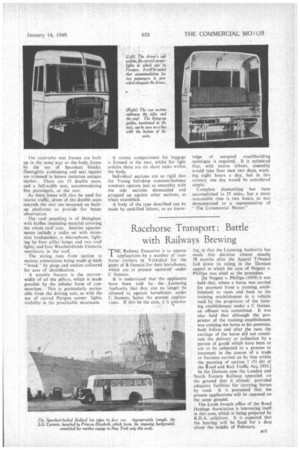31-seater Tubular Frame Body-32 . Li
Page 44

Page 45

If you've noticed an error in this article please click here to report it so we can fix it.
Electrically Welded Steel -tube Framework Forms Foundation for Knock-down Body
IT :s being generally realized that the overseas buyers' market is gradually disappearing. with the result that British manufacturers will have to adopt ways and means of making their products more keenly competitive, without jeopardizing future trade by lowering that standard of quality and workmanship for which they are renowned.
In the bodybuilding industry this represents something of a problem. as if the long-established coachbuilding principles of construction be adhered to, it would seem that keener prices could be quoted only by the use of inferior materials. A clean breakaway from accepted methods appears to be the most practical way out, and this is the plan being followed by I. H. Sparshatt and Sons (Southampton), Ltd., The Causeway. Redbridge, Southampton, in the construction of a large number of bus bodies at present being built to meet an overseas order.
The Main Structure
The foundation of the body is built up from steel tubing, the members forming the main structure being 1} ins. in diameter by 16 gauge, with 1 in. diameter tube for the roof bends and other members not subjected to the main stresses. The method of fabricating the sections, of which there are 10 in the complete body, is by the Sparshatt patented block and arc welding.
In its simplest form the Sparshatt block is a short length of steel bar bored out to a clearing size for the tube, This block is then split on one face from end to end, so that, after the tube ends have been inserted, pressure on the block will cause it to grip the tubes.
While thus held, the gap in the block
B 1 0
is electrically welded, penetration being carried down to the tube, The welding is carried over the ends of the block for a in. or so. and the block and tube may be tacked at other points if thought necessary.
Including two lengths of floor, the 10 sections comprise the complete front or driver's compartment, with its roof, leftand right-hand sides to the first window pillar, leftand right-hand sides to the third window pillar, the rear end complete, and two lengths of roof.
The sections, are held together by high-tensile steel bolts which pass through steel members electrically welded to the tubes at appropriate points. To simplify assembly, and to ensure correct alignment, tapered steel plugs in one member register with the open-ended tube in another. This ensures correct longitudinal location, and limit stops on the steel junction members permit flush assembly of the body sides.
Strong and Light
The frame structure weighs only 11 cwt., and the complete 31-seater body, 32 cwt. The total weight of the vehicle, Using a Bedford passenger chassis as a basis, is 3 tons 12 cwt.
All exterior panels arc in aluminium. the metal being wrapped round the tubing and 'pop-riveted. There is not a rivet head or screw visible on the exterior, as even the aluminium moulding is held in position by Weathershields "concealed" rubbei channelling.
Drumming is effectively prevented by the use of Sorb° packing strips secured to the frame members in those areas Where the panels would otherwise he free to vibrate. At all points where a level surface is impaired by the raised junction blocks, aluminium strips are employed. The floor is of corrugated aluminium alloy and is secured to the tubular base structure by pop-riveting. The sockets for the seat pillars are electrically welded to the same structure. The steel-tube seat frames are built up in the same way as the-body frame by the use of Sparshatt blocks. DunIqpillo cushioning and seat. squabs are trimmed in brown imitation antique leather. There are 13 double seats, and a full-width seat, accommodating five passengers, at the rear.
As these buses will also be used for tourist traffic, seven of the double seats towards the rear are mounted on builtup platforms to provide for better observation.
The roof panelling is of Holoplast, with Isofiex insulating material covering the whole roof area. Interior appointments include a radio set with extension loudspeaker, a microphone, lighting by four pillar lamps and two roof lights, and four Weathershields Flomatic ventilators in the roof.
The wiring runs from section to section, connections being made at -each " break " by plugs and sockets coloured for ease of identification.
A notable feature is the narrowwidth of all the pillars, which is made possible by the tubular form of construction. This is particularly noticeable from the driving seat, as with the use of curved Perspex corner lights, visibility is the practicable maximum. A roomy compartment for luggage is formed at the rear, whilst for light articles there are six short racks within the body.
Individual sections are so rigid that the Young full-drop constant-balance windows operate just as smoothly with the side sections dismantled and propped up against other sections, as when assembled.
A body of the type described can be made by unskilled labour, as no know
ledge of accepted coachbuilding technique is required. It is estimated that, with native labour, assembly would take four men two days, working eight hours a day, but in this country. one day would be considered atnple.
Complete dismantling has been accomplished in 35 mins., but a more reasonable time is two hours, as was demonstrated to a representative of "The Commercial Motor."




























































































